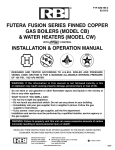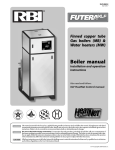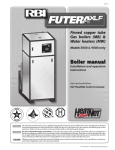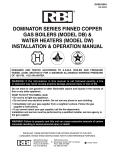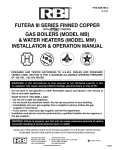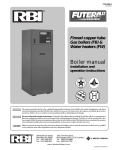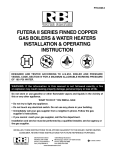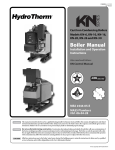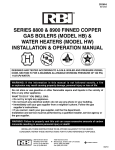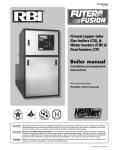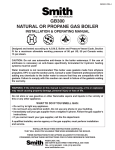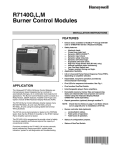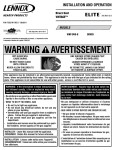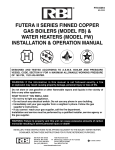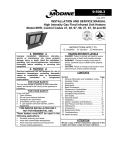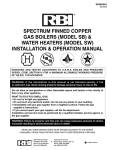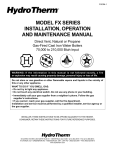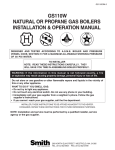Download RBI Futera Fusion XLF Operating instructions
Transcript
FTF-IOM-1R FUTERA FUSION SERIES FINNED COPPER GAS BOILERS (MODEL CB) & WATER HEATERS (MODEL CW) INSTALLATION & OPERATION MANUAL DESIGNED AND TESTED ACCORDING TO A.S.M.E. BOILER AND PRESSURE VESSEL CODE, SECTION IV FOR A MAXIMUM ALLOWABLE WORKING PRESSURE OF 160 PSI, 1103 kPa WATER. WARNING: If the information in this manual is not followed exactly, a fire or explosion may result causing property damage, personal injury or loss of life. Do not store or use gasoline or other flammable vapors and liquids in the vicinity of this or any other appliance. WHAT TO DO IF YOU SMELL GAS: • Do not try to light any appliance. • Do not touch any electrical switch. Do not use any phone in your building. • Immediately call your gas supplier from a neighbor’s phone. Follow the gas supplier’s instructions. • If you cannot reach your gas supplier, call the fire department. Installation and service must be performed by a qualified installer, service agency or the gas supplier. WARNING: Failure to properly vent this unit can cause excessive amounts of carbon monoxide resulting in severe personal injury or death! INSTALLER, THESE INSTRUCTIONS TO BE AFFIXED ADJACENT TO THE BOILER / WATER HEATER. CONSUMER, RETAIN THESE INSTRUCTIONS FOR FUTURE REFERENCE PURPOSES. 260 North Elm Street 7555 Tranmere Drive Westfield, MA 01085 Mississauga, Ontario L5S 1L4 Canada Phone: (413) 568-9571 Phone: (905) 670-5888 Fax: (413) 568-9613 Fax: (905) 670-5782 www.rbiwaterheaters.com FUTERA FUSION INSTALLATION AND OPERATION INSTRUCTIONS AVERTISSMENT. Assurez-vous de bien suivre les instructions données dans cette notice pour réduire au minimum le risque d’incendie ou d’explosion ou pour éviter tout dommoge matériel, toute blessure ou la mort Ne pas entreposer ni utiliser d’essence ou ni d’autres vapeurs ou liquides inflammables à proximité de cet appareil ou de tout autre appareil. QUE FAIRE SI VOUS SENTEZ UNE ODEUR DE GAZ: • Ne pas tenter d’allumer d’appareil. • Ne touchez à aucun interrupteur; ne pas vous servir des téléphones se trouvant dans le bâtiment. • Appelez immédiatement votre fournisseur de gas depuis un voisin. Suivez les intructions du fournisseur. • Si vous ne purvez rejoindre le fournisseur, appelez le service des incendies. L’installation et l’entretien doivent être assurés par un installateur ou un service d’entretien qualifié ou par le fournisseur de gaz. The Futera Fusion Series finned copper heating boiler/ water heaters have been design certified by CSA for use with natural and propane gas under the latest revision of ANSI-Z21.10.3/CSA 4.3, Gas Water Heaters, ANSI-Z21.13/ CSA 4.9, Gas-Fired Low Pressure Steam and Hot Water Boilers and CAN1-3.1, Industrial and Commercial Gas Fired Packaged Boilers. Each unit has been constructed and hydrostatically tested for a maximum working pressure of 160 psi, 1103 kPa in accordance with Section IV of the A.S.M.E. Boiler and Pressure Vessel Code. CONTENTS Before You Start page 2 Ratings & Capacities page 3 Boiler/Water Heater Location page 3 Combustion Air & Ventilation page 3 General Venting Guidelines page 5 General Piping Requirements page 11 Heating System Piping page 11 Domestic Water Supply Piping page 16 Gas Supply Piping page 20 Electrical Wiring page 21 General Operation page 21 Operating Instructions page 22 Checking & Adjustments page 24 Control Description page 25 MPA Staging Control page 25 Diagnostics page 27 Maintenance page 27 Trouble-Shooting page 29 Repair Parts page 31 Startup Sheet page 38 All aspects of the boiler/water heater installation must conform to the requirements of the authority having jurisdiction, or, in the absence of such requirements, to the National Fuel Gas Code, ANSI Z223.1/NFPA 54-latest revision. Where required by the authority having jurisdiction, the installation must conform to the Standard for Controls and Safety Devices for Automatically Fired Boilers, ANSI/ ASME CSD-1. In Canada, the installation must be in accordance with the requirements of CSA B149.1 or .2, Installation Code for Gas Burning Appliances and Equipment. If installed in the Commonwealth of Massachusetts, you MUST FOLLOW the additional instructions contained in RBI’s instruction sheet “MACODE”. If you don’t have a copy call your RBI representative. The owner should maintain a record of all service work performed with the date and a description of the work done. Include the name of the service organization for future reference. BEFORE YOU START This manual covers the application, installation, operation and maintenance of a Futera Fusion Series finned copper heating boiler/water heater. Direct all questions to your RBI distributor or contact the RBI Customer Service Department at: 260 North Elm Street, Westfield, MA 01085 for US or 7555 Tranmere Drive, Mississauga ONT L5S 1L4 for Canada. Always include the model and serial numbers from the rating plate of the boiler/water heater in question. To obtain the safe, dependable, efficient operation and long life for which this heating boiler/water heater was designed, these instructions must be read, understood and followed. 2 FUTERA FUSION INSTALLATION AND OPERATION INSTRUCTIONS RATINGS & CAPACITIES 6. Before under taking the installation of the Futera Fusion Series boiler/water heater check the rating plate to ensure that the unit has been sized properly for the job. The “Net I=B=R Ratings” specify the equivalent amount of direct cast iron radiation that the unit can supply under normal conditions. Also ensure that the unit has been set up for the type of gas available at the installation site. Other important considerations are the availability of an adequate electrical supply, fresh air for combustion and a suitable chimney or vent system. WARNING: Never store combustible materials, gasoline or any product containing flammable vapors or liquids in the vicinity of the boiler/water heater. Failure to comply with this warning can result in an explosion or fire causing extensive property damage, severe personal injury or death! COMBUSTION AIR & VENTILATION BOILER/WATER HEATER LOCATION 1. WARNING: This boiler/water heater must be supplied with combustion air in accordance with Section 5.3, Air for Combustion & Ventilation, of the latest revision of the National Fuel Gas Code, ANSI Z223.1/NFPA 54 and all applicable local building codes. Canadian installations must comply with CAN/ CGA B149.1 or .2 Installation Code for Gas Burning Appliances and Equipment, or applicable provisions of the local building codes. Failure to provide adequate combustion air for this boiler/ water heater can result in excessive levels of carbon monoxide which can result in severe personal injury or death! This boiler/water heater is suitable for indoor installations. Locate the boiler/water heater in an area that provides good access to the unit. Servicing may require the removal of jacket panels. Allow the minimum clearances between adjacent construction and the boiler/water heater as listed in Table 1. NOTE: Service clearances are not mandatory, but are recommended to ensure ease of service should it be required. Table 1 Top Back Left Side Right Side Front 2. 3. Clearance to Combustibles in mm 6 153 6 153 6 153 6 153 6 153 Service Clearance in mm 30 762 24 610 24 610 24 610 30 762 To operate properly and safely this boiler/water heater requires a continuous supply of air for combustion. NEVER store objects on or around the boiler/water heater! CAUTION: Combustion air contaminated with fluorocarbons or other halogenated compounds such as cleaning solvents and refrigerants will result in the formation of acids in the combustion chamber. These acids will cause premature failure of the boiler/water heater voiding the warranty! An optimum site will be level, central to the piping system, close to a chimney or outside wall and have adequate fresh air for combustion. Ensure that the boiler/water heater is level from front to back and from side to side. Use metal shims to level the boiler/water heater. Electrical and electronic components must also be protected from exposure to water during operation and maintenance. DO NOT install this boiler/water heater in a location that would subject any of the gas ignition components to direct contact with water or excessive moisture during operation or servicing. Ensure that the floor is structurally sound and will support the weight of the boiler/water heater. CAUTION: If the boiler/water heater is operated while the building is under construction it MUST be protected from wood, concrete, sheet rock and other types of dust. Failure to properly protect the unit from construction dust will damage the unit voiding the warranty! Buildings will require the installation of a fresh air duct or other means of providing make-up air if the intake air option isn’t used. Any building utilizing other gas burning appliances, a fireplace, wood stove or any type of exhaust fan must be checked for adequate combustion air when all of these devices are in operation at one time. Sizing of an outside air duct must be done to meet the requirements of all such devices. NOTE: The Futera Fusion may be installed directly on combustible flooring, but never on carpeting. 4. 5. NEVER place this boiler/water heater in a location that would subject it to temperatures at or near freezing, see the “FREEZE PROTECTION” section on page 11. Locate the boiler/water heater in an area that will prevent water damage to adjacent construction should a leak occur or during routine maintenance. If such a location doesn’t exist, a suitable drain pan that’s adequately drained must be installed under the unit. DO NOT place this boiler/water heater in a location that would restrict the introduction of combustion air into the unit or subject it to a negative pressure, see “GENERAL VENTING GUIDELINES”. WARNING: Never operate the Futera Fusion in an environment subjected to a negative pressure unless it is Direct Vented. Failure to comply with this warning can result in excessive levels of carbon monoxide causing severe personal injury or death! 3 FUTERA FUSION INSTALLATION AND OPERATION INSTRUCTIONS All Air From Inside The Building If the Futera Fusion is to be located in a confined space, the minimum clearances listed in Table 1 must be maintained between it and any combustible construction. When installed in a confined space without the intake air option, Figures 5, and 6, two permanent openings communicating with an additional room(s) are required. The combined volume of these spaces must have sufficient volume to meet the criteria for an unconfined space. The total air requirements of all gas utilization equipment, fireplaces, wood stoves or any type of exhaust fan must be considered when making this determination. Each opening must have a minimum free area of 1 in2/1000 Btu/hr, 2200 mm2/kW based on the total input rating of ALL gas utilization equipment in the confined area. Each opening must be no less than 100 in2, 64,516 mm2 in size. The upper opening must be within 12 in, 305 mm of, but not less than 3 in, 76 mm from, the top of the enclosure. The bottom opening must be within 12 in, 305 mm of, but not less than 3 in, 76 mm from, the bottom of the enclosure. Table 2 – Make-up Air Louver Sizing Required Cross Sectional Area 25% Free Area Input 1/4 in 6.4 mm 75% Free Area (MBH) Wire Screen Metal Louvers Wooden Louvers cm2 in2 cm2 in2 cm2 in2 500 125 806 167 1077 500 3226 750 187 1206 250 1613 750 4839 1000 250 1613 333 2148 1000 6452 1250 313 2019 416 2684 1250 8065 1500 375 2419 500 3226 1500 9677 1750 437 2819 583 3761 1750 11,290 1999 500 3226 667 4303 2000 12,900 All Air From Outside The Building When installed in a confined space without utilizing the intake air option two permanent openings communicating directly with, or by ducts to, the outdoors or spaces that freely communicate with the outdoors must be present. The upper opening must be within 12 in, 305 mm of, but not less than 3 in, 76 mm from, the top of the enclosure. The bottom opening must be within 12 in, 305 mm of, but not less than 3 in, 76 mm from, the bottom of the enclosure. Intake Air Option – General Guidelines This configuration provides combustion air directly to the boiler/water heater’s air intake using a dedicated pipe when using the direct vent option. The RBI air intake adapter must be fitted to the blower inlet. Combustion air can be drawn in horizontally through the same outside wall which terminates the exhaust gases or vertically through the roof, see Figures 1, 2, 3 & 4. Canadian installations must comply with CSA B149.1 when air supply is provided by natural air flow from the outdoors for natural draft, partial fan-assisted, fan-assisted, or power draft-assisted burners, there shall be a permanent air supply opening(s) having a cross-sectional area of not less than 1 in2 per 7,000 Btuh (310 mm2 per kW) up to and including 1 million Btuh, plus 1 in2 per 14,000 Btuh (155 mm2 per kW) in excess of 1 million Btuh. WARNING: Common intake air systems may be used provided the common duct is sized properly and an intake combustion air damper is installed in the intake air pipe of each heater. Improper installation can result in excessive levels of carbon monoxide which can cause severe personal injury or death! Where directly communicating with the outdoors or communicating with the outdoors through vertical ducts, each opening shall have a minimum free area of 1 in2/4000 Btu/hr, 550 mm2/kW of the total input rating of all of the equipment in the enclosure. Where communicating with the outdoors through horizontal ducts, each opening shall have a minimum free area of 1 in2/2000 Btu/hr, 1100 mm2/kW of the total input rating of all of the equipment in the enclosure. Single wall galvanized smoke pipe, single wall aluminum pipe, flexible aluminum pipe, PVC or CPVC pipe can be used for the intake air pipe. It must be sized per Table 3. When ducts are used, they must have the same crosssectional area as the free area of the opening to which they connect. Table 3 - Intake Air Pipe Sizing Model For Vertical Size in mm 500 8 203 750 8 203 1000 8 203 1250 10 254 1500 10 254 1750 12 305 2000 12 305 When calculating the free area necessary to meet the make-up air requirements of the enclosure, consideration must be given to the blockage effects of louvers, grills and screens. Screens must have a minimum mesh size of 1/4 in, 6.4 mm. If the free area through a louver or grill is not known, ducts should be sized per Table 2. For Horizontal (Up To 60') in mm 6 152 6 152 6 152 8 203 10 254 12 305 12 305 All joints in metal intake air systems must be secured using corrosion resistant fasteners and sealed using a suitable Silicone caulk. If PVC or CPVC is used, the joints must be cleaned with a suitable solvent and connected using a solvent based PVC cement. The combustion air system MUST be supported by the building structure not the boiler/water heater. 4 FUTERA FUSION INSTALLATION AND OPERATION INSTRUCTIONS CAUTION: A combustion air damper interlocked with the unit should be installed in the intake air pipe when the infiltration of subfreezing air could occur, otherwise the unit could freeze up voiding the warranty! VENT SYSTEM OPTIONS The Futera Fusion may be vented the following ways: Intake Air Option – Vertical Guidelines The maximum equivalent length for the vertical intake air pipe is 60 ft, 18.3 m. Each 90˚ elbow and the intake air terminal are equal to 10 linear ft, 3.0 m of pipe, see Table 3. 1) Direct Vent, Positive Pressure, Category IV uses a vent system certified to UL 1738 for installations in the United States, ULC S636 for installations in Canada. Combustion air is piped from the outdoors to the blower inlet. 2) Side Wall Vent, Positive Pressure, Category IV uses a vent system certified to UL 1738 for installations in the United States, ULC S636 for installations in Canada. Combustion air is obtained from the space in which the unit is installed. 3) Must consult factory when venting single or multiple unit(s) over 60 equivalent feet. Mechanical system may be required. An approved, nonrestrictive intake air terminal must be used. The intake air terminal must terminate as shown in Figure 3. The penetration point in the roof must be properly flashed and sealed. Intake Air Option – Horizontal Guidelines The maximum equivalent length for the horizontal intake air pipe is 60 ft, 18.3 m. Each 90˚ elbow and the intake air terminal are equal to 10 linear ft, 3.0 m of pipe. If horizontal runs exceed 5 ft 1.5 m they must be supported at 3 ft, 0.9 m intervals with overhead hangers. The certified intake air terminal from RBI must be used, see Figures 1, 2 and 4. NOTE: All venting, combustion air material supplied by installer. GENERAL VENTING GUIDELINES WARNING: The vent installation must be in accordance with Part 7, Venting of Equipment, of the National Fuel Gas Code, ANSI Z223.1/NFPA 54latest revision or applicable provisions of the local building codes. Canadian installations must comply with CAN/CGA B149.1 or .2 Installation Code. Improper venting can result in excessive levels of carbon monoxide which can result in severe personal injury or death! All vent systems must be fully supported by the building structure and not by the boiler/water heater. Appropriate thimbles and fire-stops must be used where required. WARNING: Common vent systems must be properly engineered and sized, please contact the factory. 5 FUTERA FUSION INSTALLATION AND OPERATION INSTRUCTIONS Horizontal vent systems shall terminate at least 4 ft, 1.2 m below, 4 ft, 1.2 m horizontally from or 1 ft, 0.30 m above any door, window or gravity air inlet into any building. It must not terminate less than 4 ft, 1.2 m horizontally from, and in no case above or below, unless a 4 ft, 1.2 m horizontal distance is maintained, from electric meters, gas meters, regulators and relief equipment and not less than 7 ft, 2.1 m from any adjacent public walkway. The bottom of the vent terminal(s) shall be located at least 5 ft, 1.5 m above the air intake terminal(s) unless there is a minimum 5 ft, 1.5 m horizontal separation between them. Avoid terminal locations likely to be affected by winds, snowdrifts, people and pets. Protect building materials and vegetation from degradation caused by the flue gases. DIRECT VENT, POSITIVE PRESSURE, CATEGORY IV In this configuration the boiler/water heater blower is used to push the flue products to the outdoors while drawing combustion air from the outdoors. The Intake Air Option instructions under the “COMBUSTION AIR & VENTILATION” section must be followed! The vent system must be sized per Table 4. Table 4 – Category IV Model Size 500 750 1000 1250 1500 1750 2000 Pipe Diameter (Min.) (Up to 60') in mm 7 178 7 178 7 178 8 203 8 203 10 254 10 254 Vertical Direct Vent Systems – Figure 3 If any part of a single wall metal vent system passes through an unheated space, it must be insulated with insulation rated for 400˚F, 204°C. Structural penetrations must be made using approved fire-stops. Horizontal Direct Vent Systems – Figures 1 & 2 The vent materials used in horizontal vent systems must be certified to UL 1738 for installations in the United States, ULC S636 for installations in Canada. The certified vent terminal from RBI must also be used. An approved, nonrestrictive vent terminal must be used. The top of a vertical vent system must extend at least 51/2 ft, 1.7 m above the roof surface and maximum snow line that it passes through, 4 ft, 1.2 m above the intake air terminal, see Figure 3. The maximum equivalent length for the horizontal vent pipe is 60 ft, 18.3 m. Each 90˚ elbow and the vent terminal are equal to 10 linear ft, 3.0 m of pipe. If any part of a single wall metal vent system passes through an unheated space, it must be insulated with insulation rated for 400° F, 204°C. Structrual penetrations must be made using approved firestops. For best results, horizontal vent systems should be as short and straight as possible. In addition the vent system must conform to the dimensions shown in Figure 3. The penetration point in the roof must be properly flashed and sealed. The vent system must be gas tight. All seams and joints in metal pipes must be joined and sealed in accordance with the vent system manufacturer’s instructions. Combination Direct Vent Systems – Figure 4 The boiler/water heater can be vented vertically with the intake air piped horizontally through an outside wall. Follow the instructions in the Intake Air Option – Horizontal Guidelines. Also follow the general instructions in the “COMBUSTION AIR & VENTILATION” and “GENERAL VENTING GUIDELINES” sections. The vent system must be both gas tight and watertight. All seams and joints in metal pipes must be joined and sealed in accordance with the vent system manufacturer’s instructions. When horizontal vent runs exceed 5 ft, 1.5 m they must be supported at 3 ft, 0.9 m intervals with overhead hangers. The vent system must be pitched back, towards the secondary heat exchanger, 1/4 in/ft, 20 mm/m. If any part of a single wall metal vent system passes through an unheated space it must be insulated with insulation rated for 400˚F, 204°C. 6 FUTERA FUSION INSTALLATION AND OPERATION INSTRUCTIONS Figure 1– Horizontal Combustion Air and Venting for a Single Unit 1/4 IN. PER FOOT 20 mm/m 16 FT 4.9 m 1.5 FT 0.5 m 9 Vertical Distance, Y 8 7 6 2000 & Larger 5 1201 To 2000 4 901 To 1200 200 To 900 3 2 1000 BTU'S 1 0 0 5 10 15 20 Horizontal Distance, X When running horizontal combustion air and venting for single or multiple units, exhaust and combustion air terminals must be installed on the same plane (outside wall) in order to prevent pressure differences due to prevailing winds. In cold climates, double-wall or insulated inlet pipe recommended to prevent condensation. Figure 2 – Horizontal Combustion Air and Venting for Multiple Units 2 IN. 5.0 cm 1.5 FT 0.5 m 7 FUTERA FUSION INSTALLATION AND OPERATION INSTRUCTIONS Figure 3 - Vertical Air Intake and Venting for Direct Vent System 10 FT 3.1 m 4 FT 1.2 m 5 1/2 FT 1.7 m 1.5 FT 0.5 m 5 FT 1.5 m Figure 4 – Combination Direct Vent Systems 3 FT. 1 m 10 FT. 3.1 m 1.5 FT. .5 m 8 FUTERA FUSION INSTALLATION AND OPERATION INSTRUCTIONS SIDE WALL VENT, POSITIVE PRESSURE, CATEGORY IV In this configuration the boiler/water heater blower is used to push the flue products horizontally to the outdoors, see Figure 5. The air for combustion is taken from the space in which the unit is installed. The applicable instructions under the “COMBUSTION AIR & VENTILATION” section must be followed! The vent guidelines under the Horizontal Direct Vent Systems section must also be followed. Figure 5 – Side Wall Venting 1/4 IN. PER F00T 20 mm/m 1.5 FT 0.5 m 9 FUTERA FUSION INSTALLATION AND OPERATION INSTRUCTIONS Figure 6 – Vertical Venting with a Metal Chimney System 10 FT. 3.1 m 10 FUTERA FUSION INSTALLATION AND OPERATION INSTRUCTIONS Flow Switch The flow switch supplied with the boiler/water heater must be wired to the terminal strip in the control panel to prevent the boiler from firing unless there’s adequate water flow through the unit. The flow switch must be installed in the supply piping adjacent to the boiler outlet connection. GENERAL PIPING REQUIREMENTS CAUTION: Improper piping of this boiler/water heater will void the manufacturer’s warranty and can cause boiler failure resulting in flooding and extensive property damage! Excessive water hardness causing scaling in the copper heat exchanger tubes is NOT covered under the manufacturer’s warranty, see Table 7. Excessive pitting and erosion of the internal surface of the copper heat exchanger tubes is NOT covered under the manufacturer’s warranty if the result of high water flow rates, see Table 7. CAUTION: Failure to properly install the flow switch may result in damage to the boiler/water heater heat exchanger voiding the warranty! HEATING SYSTEM PIPING General Piping Requirements All heating system piping must be installed by a qualified technician in accordance with the latest revision of the ANSI/ASME Boiler and Pressure Vessel Code, Section IV, and ANSI/ASME CSD-1, Standard for Controls and Safety Devices for Automatically Fired Boilers. All applicable local codes and ordinances must also be followed. A minimum clearance of 1 in, 25 mm must be maintained between heating system pipes and all combustible construction. All heating system piping must be supported by suitable hangers not the boiler. The thermal expansion of the system must be considered when supporting the system. A minimum system pressure of 12 psig, 82.7 kPa must be maintained. NOTE: Shut off valves and unions should be installed at the inlet and outlet connections of the boiler/hot water heater to provide for isolation of the unit should servicing be necessary. Freeze Protection Installations in areas where the danger of freezing exists are not recommended unless proper freeze protection is provided. The following precautions MUST be observed: 1. A continuous flow of water through the unit MUST be maintained! The pump responsible for flow through the boiler/water heater must run continuously! 2. An ethylene glycol/water mixture suitable for the minimum temperature that the unit will be exposed to must be used. The pump must be capable of producing a minimum of 15% more flow and overcoming a 20% increase in head loss. Domestic water systems must be isolated from the water heater by the use of a heat exchanger or other approved method. 3. If the unit must be shut off for any reason the electric, gas and water supplies MUST be shut off and the unit and its pump completely drained. Heating Boiler Piping Connections The supply and return connections should be sized to suit the system, see Table 6. Table 6 – Supply & Return Pipe Sizing Model Size Supply Size Return Size 500 thru 1000 2" NPT 2" NPT 1250 thru 2000 2 1/2" NPT 2 1/2" NPT Condensate Piping The condensate trap provided with the boiler must be attached to the bottom pan and piped to a suitable floor drain or condensate pump. If a condensate neutralization device is installed, it must be positioned prior to boiler room drain. Condensate fill trap must be maintained with fluid. Pump Requirements This low mass boiler requires a continuous minimum water flow for proper operation. The system pump must be sized to overcome the head loss of the boiler and the heating system in order to achieve the required temperature rise. Table 7 provides the heat exchanger pressure drop and temperature rise figures. The temperature rise across the boiler must never exceed 35˚F, 19.4˚C. The adjustable pump delay turns the pump on each time the burner fires and runs the pump for 20 to 600 seconds after the call for heat is satisfied. Relief Valve Pipe the discharge of the pressure relief valve as shown in Figure 8. WARNING: Never install any type of valve between the boiler/water heater and the relief valve or an explosion causing extensive property damage, severe personal injury or death may occur! 11 FUTERA FUSION INSTALLATION AND OPERATION INSTRUCTIONS Figure 8 – Futera Fusion Piping Pump Valve Balance Valve Pressure Reducing Valve Check Valve Pressure Relief Valve Flow Switch Thermometer Aquastat Union Automatic Air Vent Temperature & Pressure Relief Valve Vacuum Relief Valve Drain Valve (Typ.) 3-Way Mixing Valve 12 FUTERA FUSION INSTALLATION AND OPERATION INSTRUCTIONS CAUTION: A temperature rise outside of the range listed in Table 7 indicates that the flow rate through the heat exchanger is incorrect which will damage the heat exchanger voiding the warranty! The maximum allowable temperature rise is 35°F, 19.4°C. Low Water Cutoff If a boiler is installed above any radiation elements it must be fitted with a low water cutoff device. Refer to the wiring diagram supplied with the boiler/water heater for proper wiring connections. The maximum allowable flow rate through a Futera Fusion boiler is 97 GPM, 6.1 L/s on 500 through 1000 models and 136 GPM, 8.6 L/s for 1250 through 2000 models. The Cupro-Nickel heat exchanger allows for 108 GPM, 6.8 L/s on 500 through 1000 models and 151 GPM, 9.5 L/s on 1250 through 2000 models. Expansion Tank & Air Separator An expansion tank or other means to control thermal expansion must be installed in the heating system. An expansion tank must be installed close to the boiler on the suction side of the pump. An air scoop and automatic air vent must also be installed to eliminate air trapped in the system. Table 7 - Temperature Rise Table ΔT = 15°F ΔT = 8.3°C Model Number Flow Rate GPM Total Loss* Ft Flow Rate L/s 500 58.0 8.8 3.7 ΔT = 20°F Primary/Secondary Piping Figure 9 shows a typical primary/secondary piping system. Boilers connected to heating systems using zone valves, zone pumps, or systems that have excessive flow rates must be isolated from these systems to protect the boiler. Total Loss* kPa 26.3 ΔT = 11.1°C Model Number Flow Rate GPM Total Loss* Ft Flow Rate L/s 750 65.3 10.5 4.1 31.4 1250 108.8 11.6 6.9 34.7 ΔT = 25°F Multiple Boiler Systems Systems using multiple boilers can also be installed using a primary/secondary manifold system, Figure 11. Total Loss* kPa Piping For Use With Cooling Units The boiler, when used in connection with a refrigeration system, must be installed so the chilled medium is piped in parallel with the boiler. Appropriate valves must be used to prevent the chilled water from entering the boiler. ΔT = 13.9°C Model Number Flow Rate GPM Total Loss* Ft Flow Rate L/s 750 52.2 7.7 3.3 23.0 1250 87.0 8.2 5.5 24.4 1500 104.4 11.6 6.6 34.7 1750 121.8 14.7 7.7 43.9 ΔT = 30°F Total Loss* kPa When a boiler is connected to a heating coil that may be exposed to refrigerated air from an air handling device, the piping system must be equipped with flow-control valves or some other automatic means of preventing gravity circulation of the boiler water during the cooling cycle. ΔT = 16.7°C Model Flow Rate Total Loss* Flow Rate Number GPM Ft L/s Total Loss* kPa 1000 58.0 9.5 3.7 28.4 1500 87.0 8.5 5.5 25.4 1750 101.5 10.6 6.4 31.7 2000 116.0 13.8 7.3 41.2 *Includes primary, secondary, mixing valve and piping. 13 FUTERA FUSION INSTALLATION AND OPERATION INSTRUCTIONS Figure 9 - Typical Primary/Secondary, Low Temperature Piping System (See Notes) Pump Valve Balance Valve 1 Pressure Reducing Valve Check Valve Pressure Relief Valve Flow Switch 2 Thermometer Aquastat Union Automatic Air Vent H-16 Temperature & Pressure Relief Valve NOTES: 1. Boiler circuit piping must be sized large enough to handle maximum flow through unit. 2. Boiler and pump purging required. Air must be purged from 3-way valve after the boiler is filled. Use purge valves provided. Purge valve may be located on pump flange. On multiple boiler installations the flow switch may fail due to trapped air. See manual for procedure. 3. All boilers furnished with factory mounted outlet water temperature gauge. Vacuum Relief Valve Drain Valve (Typ.) Notice: These drawings show suggested piping configuration and valving. Check with local codes and ordinances for specific requirements. 3-Way Mixing Valve 14 FUTERA FUSION INSTALLATION AND OPERATION INSTRUCTIONS Figure 11 - Multiple Boiler Piping (See notes) Pump Valve 2 Balance Valve Pressure Reducing Valve Check Valve 1 Pressure Relief Valve Flow Switch Thermometer Aquastat Union Automatic Air Vent 3 Temperature & Pressure Relief Valve 3 Vacuum Relief Valve NOTES: Factory Piped H-17 Drain Valve (Typ.) 3-Way Mixing Valve NOTES: 1. Boiler circuit piping must be sized large enough to handle maximum flow through each unit. 2. System loop pipe diameter must be sized large enough to handle maximum flow through all units. 3. Boiler and pump purging required. Air must be purged from 3-way valve after the boiler is filled. Use purge valves provided. Purge valve may be located on pump flange. On multiple boiler installations the flow switch may fail due to trapped air. See manual for procedure. 4. All boilers furnished with factory mounted outlet water temperature gauge. 5. Condensate lines on each unit should be connected for a floor drain. Notice: These drawings show suggested piping configuration and valving. Check with local codes and ordinances for specific requirements. 15 FUTERA FUSION INSTALLATION AND OPERATION INSTRUCTIONS RBI water heaters are designed to run scale free. Due to the extreme variables of water conditions world wide it is necessary to consider pH values and water hardness in relationship to scaling. It is crucial to consider these two variables when making heat exchanger and pump selections. If local water conditions are extreme, follow the guidelines in the Heat Exchanger Selection Table (Table 8A). Scale free operation can be achieved by using water with a hardness between 8 and 18 and by maintaining the pH between 5 and 9. Follow the conditions listed under NORMAL in the table. In some areas of the country additional precautions must be observed due to unusual characteristics of the local water supply. Call the nearest RBI representative for details. DOMESTIC WATER SUPPLY PIPING CAUTION: Proper controls must be used to prevent water supplied for domestic use from exceeding 130˚F, 54˚C or a scald injury will occur! When higher water temperatures are required for appliances such as a dishwasher, a mixing valve or some other tempering means must be installed. Households with small children may require water temperatures less than 120˚F, 49˚C. Local codes must be complied with! General Piping Requirements Ensure that the water heater is equipped with bronze headers. Piping and components connected to the water heater must be suitable for use with potable water. The water heater must not be connected to any heating system piping or components previously used with a non-potable water heating appliance. No toxic chemicals, such as those used for boiler treatment, are to be introduced into the potable water used for space heating. If a hot water storage tank is used in the system it must be equipped with a temperature and pressure relief valve that complies with ANSI Z21.22 or CAN-4.4 and CAN-4.6. Expansion Tank An expansion tank or other means to control thermal expansion must be installed in the water heating system if back flow prevention devices are installed. Pump Requirements This low-mass water heater requires a continuous minimum water flow for proper operation. The proper velocity through the water heater must be maintained in accordance with Table 7 for efficient operation and long life. If the temperature rise through the water heater is lower than recommended the water velocity is too high. Premature erosion of the heat exchanger will occur. Conversely, if the temperature rise is higher than recommended in Table 7 the flow rate is too low. Scaling and softening of the heat exchanger will occur. The temperature rise across the water heater must never exceed 35°F, 19.4°C. NOTE: The storage tank must be located as close to the water heater as possible to prevent excessive head loss which will reduce flow. Bleed Air From Boiler Open the water heater piping bleed valves one at a time, to purge the air trapped in the primary and secondary heat exchangers. Refer to piping drawings (Figures 12 & 13) for bleed locations. Storage Tank Thermostatic Mixing Valve – Water Above 140˚F, 60˚C Water can be stored at temperatures above 140˚F, 60˚C provided that a thermostatically controlled mixing valve is used to temper the hot water to an acceptable temperature before it’s supplied for domestic use. Water Chemistry The required temperature rise across the water heater is based on water having a hardness between 8 and 18 grains per gallon with a level of dissolved solids not exceeding 350 ppm. Water having a hardness less than 8 grains can cause excessive corrosion of the heat exchanger. Water that has a hardness greater than 18 grains per gallon and/or a level of dissolved solids exceeding 350 ppm will require a recalculation of the pump size and temperature rise. The mixing valve MUST be set to prevent a scald injury from occurring, see the caution against scalding. Storage of water for domestic use above 140°F, 60°C will provide an increased quantity of tempered water and help prevent the growth of water born bacteria. A cupro-nickel heat exchanger may also be required. The manufacturer should be consulted when these water conditions are encountered. See Table 8A. CAUTION: The maximum allowable flow rate through a Futera Fusion water heater is 97 GPM, 6.1 L/s on 500 through 1000 models and 136 GPM, 8.9 L/s for 1250 through 2000 models. The cupro-nickel heat exchanger allows for 108 GPM, 6.8 L/s on 500 through 1000 models and 151 GPM, 9.5 L/s on 1250 through 2000 models. 16 FUTERA FUSION INSTALLATION AND OPERATION INSTRUCTIONS Table 8A - Futera Fusion Heat Exchanger Selection Graph To properly size the pump a grain hardness and pH test must be taken at the installation site before the order is placed. Proper For hard/soft water pump selection, must consult factory. pump sizing will improve heater performance and help ensure heater longevity. 17 FUTERA FUSION INSTALLATION AND OPERATION INSTRUCTIONS Figure 12 - Typical Water Heating Piping (CW Models Only) (See Notes) Pump Valve Balance Valve Pressure Reducing Valve 7 8 Check Valve 8 Pressure Relief Valve Flow Switch Thermometer 5 Aquastat Union 1 D-17 Automatic Air Vent 2 Temperature & Pressure Relief Valve 6 Vacuum Relief Valve NOTES: Drain Valve (Typ.) 3-Way Mixing Valve NOTES: 1. When using intermittent pump and pump delay, locate remote aquastat well in lower 1/3 of tank. Install aquastat with heat sensing compound. 2. Thermal expansion tank may be required, check local codes. 3. CAUTION: MEASURE WATER HARDNESS AND pH AT JOB SITE. Be sure to specify when ordering the pH and water hardness. This must be measured before selecting heat exchanger and pump. Consult the Heat Exchanger Graph and Pumping Performance Table before making selection. 4. Common piping must be sized for maximum combined heater flow. 5. Hot water tanks should be equipped with a combination temperature & pressure relief valve. 6. MA Code requires an 1/8" hole in check valve to compensate for thermal expansion. 7. Use balance valve to set the temperature rise through the boiler. (Delta T) 8. Boiler and pump purging required. Air must be purged from 3-way valve after the boiler is filled. Use purge valves provided. Purge valve may be located on pump flange. On multiple boiler installations the flow switch may fail due to trapped air. See manual procedure. Notice: These drawings show suggested piping configuration and valving. Check with local codes and ordinances for specific requirements. 18 FUTERA FUSION INSTALLATION AND OPERATION INSTRUCTIONS Figure 13 - Multiple Water Heating Piping (CW Models Only) (See Notes) Pump Valve Balance Valve Pressure Reducing Valve 7 1 8 Check Valve 8 7 8 4 2 Pressure Relief Valve 8 6 Flow Switch 5 Thermometer 2 5 Aquastat Union 1 4 Automatic Air Vent D-18 Temperature & Pressure Relief Valve Vacuum Relief Valve Drain Valve (Typ.) NOTES: 1. When using intermittent pump and pump delay, locate remote aquastat well in lower 1/3 of tank. Install aquastat with heat sensing compound. 2. Thermal expansion tank may be required, check local codes. 3. CAUTION: MEASURE WATER HARDNESS AND pH AT JOB SITE. Be sure to specify when ordering the pH and water hardness. This must be measured before selecting heat exchanger and pump. Consult the Heat Exchanger Graph and Pumping Performance Table before making selection. 4. Common piping must be sized for maximum combined heater flow. 5. Hot water tanks should be equipped with a combination temperature & pressure relief valve. 6. MA Code requires an 1/8" hole in check valve to compensate for thermal expansion. 7. Use balance valve to set the temperature rise through the boiler. (Delta T) 8. Boiler and pump purging required. Air must be purged from 3-way valve after boiler is filled. Use purge valves provided. Purge valve may be located on pump flange. On multiple boiler installations the flow switch may fail due to trapped air. See manual procedure. Notice: These drawings show suggested piping configuration and valving. Check with local codes and ordinances for specific requirements. 19 3-Way Mixing Valve FUTERA FUSION INSTALLATION AND OPERATION INSTRUCTIONS Table 9 – Gas Pipe Capacity GAS SUPPLY PIPING Maximum pipe capacity in ft3/hr based on 0.60 specific gravity gas at a pressure of 0.5 psig or less and a 0.3" WC pressure drop. Nominal Pipe length in feet 30 40 Iron Pipe 10 50 60 80 100 150 20 Maximum gas volume of pipe, (ft3/hr) Size, (in) 520 350 285 245 215 195 170 150 120 1" 1050 730 590 500 440 400 350 305 250 1 1/4" 1600 1100 890 760 670 610 530 460 380 1 1/2" 3050 2100 1650 1270 1270 1150 990 870 710 2" WARNING: Check the boiler/water heater rating plate to make sure that the boiler/water heater is for the type of gas that will be used. If it isn’t, do not connect the boiler/water heater to the gas supply. Gas supply piping must be in accordance with the National Fuel Code, ANSI Z223.1-latest revision or applicable provisions of the local building codes. Canadian installations must comply with CAN/CGA B149.1 or .2 Installation Code. Failure to comply with this warning can result in extensive property damage, severe personal injury or death! Note: Multiply the gas volume by 0.62 for propane flow capacity in ft3/hr. Multiply the propane flow capacity by 2500 Btu/ft3 to determine the propane Btu/hr capacity for a given pipe size and length. Table 10 – Equivalent Pipe Length Chart The Futera Fusion comes from the factory ready to be piped to the gas supply. If for any reason the boiler/water heater is not for the type of gas available at the installation site, call your RBI representative to resolve the problem. Type of pipe fitting Nominal 90˚ Elbow Tee1 Gate Valve2 Gas Cock2 Iron Pipe Equivalent pipe length, (ft) Size, (in) 1.5 2.6 5.2 0.6 1" 1.9 3.5 6.9 0.8 1 1/4" 2.3 4.0 8.0 0.9 1 1/2" 3.0 5.2 10.3 1.2 2" Notes: 1. For flow through branch. 2. For flow at full open. NOTE: A minimum gas supply pressure of 2 in, 51 mm, W.C. natural or propane and maximum 14 in, 356 mm W.C. natural or propane, must be available at the safety shutoff valve inlet with the unit(s) operating. Figure 14 – Gas Supply Piping Table 9 should be used to ensure that the gas supply piping is sized properly. If more than one appliance is supplied by the same supply pipe, the piping must be sized based on the maximum possible demand. Do not neglect the pressure drop due to pipe fittings. Table 9 should be used in conjunction with Table 10 to ensure that the gas supply piping has the capacity to meet the demand. Figure 14 depicts the proper way to connect the boiler/ water heater to the gas supply piping. The manual shutoff valve MUST be installed in the supply piping. It should be installed 5 ft, 1.5 m above the floor where required by local codes. Provide a sediment trap at the bottom of the vertical section of the gas supply pipe upstream of the gas controls. A ground joint union should be installed between the boiler gas controls and the supply piping. Each of these items are needed to ensure long life and ease of servicing. Always use a pipe sealant that is suitable for use with LP gas. CAUTION: Always use a wrench on the gas valve body when making gas connections to it. Never over-tighten the piping entering the gas valve body or gas valve failure may result! When applicable, provisions for vent, bleed and gas relief lines must be made in accordance with the latest revision of ANSI Z223.1/NFPA 54. The main Dungs gas valve supplied with the boiler/water heater does not require external venting. Safe lighting and other performance criteria were met with the gas manifold and control assembly provided on the boiler. All gas connections MUST be leak tested before putting the boiler into operation. 20 FUTERA FUSION INSTALLATION AND OPERATION INSTRUCTIONS GENERAL OPERATION WARNING: Never use an open flame to test for gas leaks. Always use an approved leak detection method. Failure to comply with this warning can cause extensive property damage, severe personal injury or death! WARNING: Before proceeding read and fully understand the instructions contained in this manual. Do not attempt to operate this boiler/water heater if it has not been installed in accordance with the guidelines set forth in this manual. Failure to comply with this warning can result in extensive property damage, severe personal injury or death! Whenever the gas supply piping is pressure tested the boiler/water heater gas controls must be protected. If the test pressure is equal to, or less than 1/2 psig, 3.5 kPa isolate the boiler/water heater by closing it’s manual shut off valve, see Figure 14. If the test pressure is greater than, or equal to 1/2 psig, 3.5 kPa, disconnect the boiler/water heater and its individual shut-off valve. Should overheating occur or the gas supply fail to shut off, turn off the manual gas control valve to the appliance. Do not interrupt water flow through the boiler/water heater. ELECTRICAL WIRING Electrical Power Connections En cas de surchauffe ou si l’alimentation en gaz ne s’arrête pas, fermez manuellement le robinet d’arrêt de l’admission de gaz. CAUTION: Label all wires prior to disconnection when servicing controls. Wiring errors can cause improper and dangerous operation! Verify proper operation after servicing. Hydronic Heating Boilers (Fill System) Open the make-up water valve and slowly fill the boiler and all of the radiation with water. Ensure that all bleed and drain valves are closed. AT T E N T I O N : Au m o m e n t d e l ’ e n t r e t i e n d e s commandes, étiquetez tous les fils avant de les débrancher. Des erreurs de câblage peuvent entraîner un fonctionnement inadéquat et dangereux. S’assurer que l’appareil fonctionne adéquatement une fois l’entretirn terminé. Adjust the make-up water pressure regulator so a minimum 12 psig, 82.7 kPa system pressure is maintained at the highest point in the system piping. If a make-up water pump is used adjust it to maintain a minimum 12 psig, 82.7 kPa system pressure. Open the boiler piping bleed valves one at a time, to purge the air trapped in the primary and secondary heat exchanger. Refer to piping drawings (Figures 9 & 11) for bleed locations. The electrical connections to this boiler/water heater must be made in accordance with all applicable local codes and the latest revision of the National Electrical Code, ANSI/ NFPA-70. Installation should also conform with CSA C22.1 Canadian Electrical Code Part I if installed in Canada. With the boiler off, run the system pump for at least 30 minutes and bleed the system piping using the bleed valves. If strainers are used in the system piping, the makeup water valve should be closed and the strainers checked and cleaned. Install a separate 120 volt 15 amp circuit for the boiler/water heater. A properly rated shut-off switch should be located at the boiler/water heater. The boiler/water heater must be grounded in accordance with the authority having jurisdiction, or if none, the latest revision of the National Electrical Code, ANSI/NFPA-70. The system expansion tank should be checked to ensure that the correct water level in the tank is maintained. The tank should be less than half full of water with the system full and adjusted to the correct operating pressure. Line voltage field wiring of any controls or other devices must conform to the temperature limitation of type T wire at 95°F, 35°C above room temperature. Use copper conductors with a minimum size of #14 awg. Star t the boiler as described in the “OPERATING INSTRUCTIONS” section. Run the boiler for at least an hour. The system pump(s) and all radiation units must be operated during this time. Ensure that the make-up water valve is open. Refer to the wiring diagram supplied with the boiler/water heater for proper wiring connections. Shut the boiler off and open the bleed valves to purge the air trapped in the heating system piping. Close the makeup water valve and check and clean the strainers and make-up water pressure reducing valve. Open the make-up water valve and adjust the system pressure if necessary. The system should be checked and bled after three days of operation. 21 FUTERA FUSION INSTALLATION AND OPERATION INSTRUCTIONS C. Do not use this appliance if any part has been under water. Immediately call a qualified service technician to inspect the appliance and to replace any part of the control system and any gas control that has been under water. OPERATING INSTRUCTIONS FOR YOUR SAFETY READ BEFORE OPERATING. POUR VOTRE SÉCURITÉ LISEZ AVANT DE METTRE EN MARCHE N’utilisez pas cet appareil s’il a été plongé dans l’eau, même partiellement. Faites inspecter l’appareil par un tecnicien qualifié et remplacez toute partie du système de contrôle et toute commande qui ont été plongés dans l’eau. A. This appliance is equipped with an ignition device which automatically lights the pilot. Do not try to light the pilot by hand. Cet appareil est muni d’un dispositif d’allumage qui allume automatiquement la veilleuse. Ne tentez pas d’allumer la veilleuse manuellement. CAUTION: To prevent being burned, stand clear of the boiler during ignition and don’t touch any hot metal parts! B. BEFORE OPERATING smell all around the appliance area for gas. Be sure to smell next to the floor because some gas is heavier than air and will settle on the floor. Operating Instructions 1. STOP! Read the safety information above. If, at any time, the appliance will not operate properly, follow the instructions “TO TURN OFF GAS TO APPLIANCE”. DANGER: Propane gas may not always be detected by smell. Propane gas is heavier than air and can collect in low areas. Propane gas can ignite or explode if an ignition source is present and result in death, serious injury and property damage! 2. Set the operating control to off or its lowest setting. FOR YOUR SAFETY • Have only qualified licensed professionals install, service and maintain this appliance and your gas system in accordance with all applicable codes. • If you suspect a leak: 1. Have everyone leave the building immediately. 2. Do not attempt to light any appliance. 3. Do not touch any electrical or electronic switches in the building. 4. Do not use any phone in the building. 5. Call your gas supplier from a phone outside of the building. 6. If you cannot reach your gas supplier call the fire department. 4. Close manual main shut-off valves 1 and 2 and the pilot gas shut-off valve, Figure 14. 3. Turn off all electric power to the appliance. 5. Make sure that the gas supply piping has been purged of air and that all gas joints up to the gas valve have been thoroughly checked for leaks. Wait five (5) minutes to clear out any gas. Then smell for gas, including near the floor. If you smell gas, STOP! Follow “B” in the safety information above (to the left) on this label. If you don’t smell gas, go to the next step. 6. Power appliance and turn the power switch on the side of the boiler to “on”. If all interlocks are properly closed, the display will say “Standby Futera Fusion”. If this is not the case refer to the “DIAGNOSTICS” section for further information. AVANT DE FAIRE FONCTIONNER, reniflez tout autour de l’appareil pour déceler une odeur de gaz. Reniflez près du plancher, car certains gaz sont plus lourds que l’air et peuvent s’accumuler au niveau du sol. 7. A minimum gas supply pressure of 2 in, 51 mm, W.C. natural of propane and max 14 in, 356 mm W.C., natural of propane, must be available at the safety shutoff valve inlet with the unit(s) operating. QUE FAIRE SI VOUS SENTEZ UNE ODEUR DE GAZ: • Ne pas tenter d’allumer d’appareil. • Ne touchez à aucun interrupteur; ne pas vous servir des téléphones se trouvant dans le bâtiment. • Appelez immédiatement votre fournisseur de gaz depuis un voisin. Suives les instructions du fournisseur. • Si vous ne pouvez rejoindre le fournisseur, appelez le service de incendies. 8. Create a full input demand by jumping the AA terminals on control board at terminal strip J12. 9. The boiler will begin the start sequence. 22 FUTERA FUSION INSTALLATION AND OPERATION INSTRUCTIONS 2. Mettez l’appareil à l’arrêt ou réglez celui-ci au minimum. 10. Monitor the flame current on the Honeywell Burner Control 7897C. No flame current should be detected and the 7897C should lock out. If flame current is detected at any time up to the 7897C locking out, the 120V wiring on the ignition transformer must be reversed. Test again to insure that no flame is detected. 3. Coupez toute alimentation électrique de l’appareil. 4. Fermez manuellement les robinets d’arrêt principaux 1 et 2 ainsi que le robinet d’arrêt de la veilleuse. Voir figure 14. WARNING: Improper wiring of the ignition transformer can result in an explosion causing extensive property damage, severe personal injury or death! 5. Assurez-vous au préalable que la conduite d’alimentation en gaz a été purgée et que tous ses raccords jusqu’au niveau du robinet sont exempts de fuite. 11. Open the manual main shut-off valves 1 and 2 and the pilot gas shut-off valve, Figure 14. 6. Mettez l’appareil sous tension et tournez l’interrupteur situé sur le côté de la chaudière en position de marche. Si tous les interrupteurs de verrouillage sont convenablement fermés, l’affichage doit indiquer «Standby Futera Fusion». Si ce n’est pas le cas, reportez-vous à la section «DIAGNOSTIC». 12. Reset the Honeywell 7897C. The boiler will begin the start sequence. 13. When the main display reads “PILOT RUNNING” and the flame current is 5 VDC, switch the Honeywell 7897C to the “test” position. This will hold the Honeywell 7897C in its ignition state. 7. Lorsque l’appareil est en marche, la pression du gaz à l’entrée du robinet d’arrêt de sécurité doit être au minimum de 2 po, 51 mm, CE, gaz naturel ou propane et au maximum de 14 po, 356 mm, CE, gaz naturel ou propane. 14. Adjust the pilot pressure per the “CHECKING & ADJUSTMENTS”. 15. Switch the Honeywell 7897C back to “run”. 8. Créez une nette demande de chauffage au tableau de commandes en posant un cavalier sur les bornes AA (bornier J12). 16. Allow the boiler to establish main flame and modulate to full input. Check the input rate per the “CHECKING & ADJUSTMENTS” section. 9. La chaudière entamera la séquence de démarrage. 17. Move the slide switch below the display to “Min Hold”, low fire. 10. Surveillez le courant de flamme sur le régulateur du brûleur Honeywell 7897C. Aucun courant de flamme ne doit être détecté et le 7897C devrait se verrouiller. Si un courant de flamme est détecté avant le verrouillage du 7897C, le câblage 120V du transformateur d’allumage doit être inversé. Vérifiez à nouveau pour vous assurer qu’aucune flamme n’est détectée. 18. Set manifold pressure at elbow before entering cabinet to -2.95" WC (± -.1" WC) at high fire. 19. Allow the boiler to modulate to min input. Observe the burner to ensure that it is not operating in an infrared condition. Take a flue gas sample using a calibrated analyzer. Use a 2.5mm, 3/32" allen wrench to adjust the gas valve to produce a CO2 of approximately 8.5% for natural gas and 10.5% for propane. Make small 10degree adjustments and wait until the CO2 readings settle before making further adjustments. AVERTISSEMENT: Un câblage incorrect du transformateur d’allumage peut provoquer une explosion entraînant de graves blessures ou la mort et causer d’importants dégâts matériel. 11. Ouvrez manuellement les robinets d’arrêt principaux 1 et 2 ainsi que le robinet d’arrêt de la veilleuse. Voir figure 14. 20. When all adjustments are finished, move the slide switch below the display to the “Run” position and remove input by opening jumper AA. 12. Remettez à zéro le régulateur Honeywell 7897C. La chaudière commencera la séquence de démarrage. 21. The boiler allows for four modes of operation. Refer to the “MPA STAGING CONTROL” for further information. 13. Lorsque l’affichage indique ´«PILOT RUNNING» et que le courant de flamme est de 5V c.c., commutez le Honeywell 7897C en mode ´«test». Ceci permettra de le maintenir en position d’allumage. Consignes d’utilisation 1. ATTENTION! Lisez les mises en garde ci-dessus. Si vous constatez une anomalie quelconque dans le fonctionnement de l’appareil, suivez les instructions de la section «COMMENT COUPER L’ALIMENTATION DE GAZ DE L’APPAREIL». 14. Réglez la pression de la veilleuse tel qu’indiqué à la section «VÉRIFICATION ET RÉGLAGES». 15. Commutez à nouveau le Honeywell 7897C en mode «marche». 23 FUTERA FUSION INSTALLATION AND OPERATION INSTRUCTIONS Figure 16 – Spark Rod Position and Pilot Flame 16. Laisser la chaudière compléter la séquence d’allumage et atteindre son plein régime. Vérifiez le débit tel qu’indiqué à la section «VÉRIFICATION ET RÉGLAGES». SEE DETAIL A 1/4 to 7/8 OF AN in 6.4 mm TO 22.2 mm FROM TIP TO BURNER SURFACE 2 5/16 in 58.8 mm 17. Déplacez le curseur situé sous l’écran d’affichage, à la position «Min Hold», soit faible régime. 18. Laissez la chaudière atteindre son régime minimum. Observez le brûleur et vérifiez qu’il ne fonctionne pas en infrarouge. Prélevez un échantillon de gaz de combustion à l’aide d’un analyseur calibré. Réglez le robinet de gaz au moyen d’une clé Allen de 2,5mm (3/32 po) afin de produire une concentration de CO2 d’environ 8,5% pour du gaz naturel et de 10,5% pour du gaz propane. Procédez par écarts de 10 degrés et attendez que la lecture du CO2 se stabilise avant chaque nouveau réglage. RIOM-17-REV-B 10 1/8 in 257.2 mm 19. Lorsque tous les réglages ont été effectués, glissez le curseur situé sous l’écran d’affichage à la position «Run» et mettez fin à la demande en retirant le cavalier des bornes AA. DETAIL A Pilot Adjustment The pilot pressure has been factory set at 2" and shouldn't need adjustment. To check the pilot pressure close the manual main shut-off valve 2 and the pilot gas shut-off valve, Figure 14. Remove the 1/8" pipe plug from the pilot tee and connect a manometer having a minimum range of 6 in, 152 mm WC to it. Open the pilot gas shut-off valve. With the unit powered, generate a call for heat. When the prepurge is complete the ignition/pilot trial will begin. At this point put the Honeywell 7897C test switch in the test position. The control will hold in the ignition/pilot sequence allowing you to check the pressure. 20. La chaudière offre quatre modes d’opération. Reportezvous à la section ´«MPA STAGING CONTROL» pour plus de détails. To Turn Off Gas To Appliance 1. Set the operating control or thermostat to its lowest setting. 2. Turn off all electric power to the appliance if service is to be performed. 3. Close the manual main and pilot gas shut-off valves. To adjust the pilot the following steps must be taken: 1. Remove the pilot gas pressure regulator cap. COMMENT COUPER L’ADMISSION DE GAZ DE L’APAREIL 1. Réglez le thermostat à la température la plus basse. 2. Coupez l’alimentation électrique de l’appareil s’il faut procéder à l’entretien. 3. Fermer la vanne manuelle d’arrêt d’alimintation de gaz. 2. Turn the pressure regulator adjustment screw clockwise to increase the pressure and counterclockwise to decrease it. CHECKING & ADJUSTMENTS 3. Replace the pressure regulator adjustment screw cap. CAUTION: Never force the regulator adjustment screw beyond the stop limits or damage to the regulator will occur! Spark Gap With the main and pilot gas manual valves in the closed position energize the unit. Observe the trial for ignition to confirm that the spark is strong and continuous. If not check and adjust the spark gap as shown in Figures 15 &16. WARNING: The air damper adjustment must only be made by a trained technician using a combustion analyzer! Improper adjustment can result in excessive levels of carbon monoxide or an explosion resulting in severe personal injury or death! Figure 15 – Spark Gap 9 1/4 in. 235 mm FROM BOTTOM OF SPARK ROD PLATE 1/16 TO 1/8 OF AN in 1.5 mm TO 3.2 mm 24 FUTERA FUSION INSTALLATION AND OPERATION INSTRUCTIONS Required Gas Pressure Provide gas supply pressure at inlet to boiler gas train as follows: LP Nat Minimum (in W.C.) 2 2 Maximum (in W.C.) 14 14 Operating Control The preferred control setting for potable hot water is 130°F, 54°C. The operating control should be set to the lowest setting that will satisfy the consumer's needs. WARNING: Setting the thermostat or operation control too high can result in scalding resulting in severe personal injury! Measure pressure when the boiler is firing at full rate. Low gas pressure could indicate undersized gas line or insufficient gas supply. High Limit (Aquastat) The high limit is located in the top control area of the boiler/ water heater. A remote capillary bulb is run to a well on the outlet side of the supply header. The high limit can be reset by depressing the red button. “Static and operating gas pressure required at the gas valve inlet is between 2" W.C. and 14" W.C. for natural gas and 2" W.C. and 14" W.C. propane. If the gas pressure is above this limit, a lock-up style regulator suitable for dead end service such as an Equimeter or Fisher must be installed to prevent increase (creep) of gas pressure when the units are not operating. This pressure regulator (supplied by others) may be installed at the service entrance to each unit or a “master” regulator sized to handle multiple units may be utilized. Consult local gas utility or regulator manufacturer for recommendations to meet specific job site requirements.” The water heater high limit should be set a minimum of 20°F, 11°C higher than the operating control. Refer to the HOT WATER SUPPLY section for the proper supply water temperature. Flow Switch A flow switch is provided in the water outlet piping to prevent the boiler/water heater from firing without adequate water flow through the heat exchanger. Input Rate, Natural Gas Gas appliances are rated based on sea level operation with no adjustment required at elevations up to 2000 ft, 610 m. At elevations above 2000 ft, 610 m input ratings should be reduced by 4% for each 1000 ft, 305 m. MPA STAGING CONTROL This boiler control is mounted on the front panel of the boiler/water heater. It utilizes various temperature sensors to calculate boiler/water heater demand and adjust the modulation as needed. Various features of the control can be adjusted from the 3-button panel on the controller. To change settings of the modulation controller, press and hold all three buttons approximately 2 seconds until the “adjust” screen appears, then release them. The modulating control provides 4 modes of operation based on the requirements of the system. Each mode is defined below. Check the input rate as follows: 1. Turn off all other gas appliances that use the same gas meter as the boiler/water heater. 2. Call your gas supplier and ask for the heating value of the gas. 3. Start the boiler/water heater and let it run for 15 minutes. 4. Using the gas meter and a stopwatch, clock the time that it takes to burn 10 ft3, 0.28 m3 of gas and divide this time by 10. 5. Insert the heating value and the time, in seconds, into the formula below. 6. Input = (heating value, Btu/hr)(3600)/(time, seconds) 7. If the computed rate deviates by more than 5% from the rated input value of the unit, consult factory. At the rear of the controller, there is a single DIP switch. This switch is factory set to provide a “lockout” with minimum adjustment capabilities in the field. However, for experienced installers and operators, changing these switch settings can offer many fine-tuning features. Please consult the factory for assistance. CAUTION: DO NOT change DIP switch or controller settings unless you have completely read and u n d e rs t o o d t h i s d o c u m e n t a n d t h e c o n t ro l manufacturer’s instructions. Doing otherwise will lead to improper modulating control. CAUTION: Never increase the input to the boiler/water heater above that for which it is rated. Doing so can cause premature failure of the boiler! CONTROL DESCRIPTION Low Water Cutoff If the boiler is to be installed above radiation or if required by other codes or regulations, install a low water cutoff in appropriate piping. Wire the switch and any external controls in series to the "Interlock" contacts in the junction box (see the attached Connection Diagrams for details). Ensure that the low water cutoff device(s) will function properly. 25 FUTERA FUSION INSTALLATION AND OPERATION INSTRUCTIONS Boiler Purge (PMP DLY) After a demand is satisfied, the control continues to operate the boiler pump for a period of time. The length of time that the boiler pump continues to run is based on the PMP DLY setting. Once the boiler turns off, the control keeps the boiler pump running for the time selected. This setting allows purging of any excess heat out of the boiler after the boiler is shut off. Installer Level Settings Modes of Operation (MODE): The control allows for four modes of operation in order to define the control operation and piping arrangement used. Mode 1: Setpoint Control. Parallel Piping. The Futera Fusion is piped in parallel with the system. The rate of modulation is controlled to provide a setpoint temperature at the boiler/water heater outlet, whenever there is a heat demand present. When PMP DLY is set to OFF, there is no purging. When PMP DLY is set to ON, the pump runs continuously. Tank Target Temperature (TANK TARGET), Mode 3 Only The TANK TARGET setting is used to set the desired DHW tank temperature. Mode 2: Setpoint Control.Primary/Secondary Piping. The Futera Fusion is piped in a primary/secondary configuration. An additional system sensor is required to properly control the system supply (primary loop) temperature. The rate of modulation is controlled to provide the setpoint temperature in the primary loop. Tank Differential (TANK DIFF), Mode 3 Only A differential setting that operates 1/2 above and below the TANK TARGET is selectable using the TANK DIFF item in the Adjust menu. Mode 3: Domestic Hot Water (DHW) generation. The Futera Fusion is piped in parallel with the storage tank. An additional sensor is required to monitor the tank temperature. The rate of modulation is controlled to maintain the desired DHW tank temperature. Advanced Level Settings CAUTION: These settings are not to be changed unless the manufacturer is contacted. Unstable or even dangerous operation of the boiler/water heater could result. DHW Operation: A DHW demand is generated whenever the temperature sensed by the DHW sensor drops below the programmed tank target temperature by 1/2 the tank differential, adjustable from 2 to 10˚F. The demand remains until the temperature sensed by the DHW sensor rises above the programmed tank target temperature plus 1/2 the tank differential. Motor Speed: The control includes a motor speed adjustment, which sets the speed of the actuating motor that provides firing modulation. Default value is 30. Start Modulation: The start modulation is the firing rate recommended for proper burner ignition. Default value is 4%. Mode 4: External Boiler Control: The Modulating Boiler Control allows for an external boiler control to operate the boiler. Factory installed terminals are supplied inside the front cabinet of the Futera Fusion. These include boiler start contacts, 4-20mA modulating signal contacts, and boiler alarm dry contacts. A sequencer or controller must provide both boiler start contacts and a modulating signal for external control of the boiler/water heater. The modulating boiler control will display inlet and outlet temperatures as well as control the pump delay. Minimum Modulation: The minimum modulation is the firing rate the control will modulate down to during operation. This setting is based on the analog output signal, which provides low fire. Default value is 0%. Fire Delay: The fire delay is the time that the control waits at the Start Modulation output. The delay is the result of a pre-purge and trial ignition built into the boiler's safety circuits. Default value is 20 sec. Boiler Target Temperature (BOIL TARGET) The boiler target temperature is determined from the mode of operation. The control displays the temperature that it is currently trying to maintain at the operating sensor as BOIL TARGET in the View menu. The operating sensor for mode 1 is the outlet sensor. Mode 2 is the system supply sensor. Mode 3 is the tank sensor. There is no boiler target temperature generated in mode 4. Boiler Mass: The boiler mass setting allows the installer to adjust the control to the thermal mass of different types of heat sources used. The boiler mass setting automatically determines the rate of modulation. A higher thermal mass setting provides slower modulation, while a lower thermal mass provides faster modulation. Default value is 1. Boiler Minimum: The boiler minimum is the lowest water temperature that the control is allowed to use as a boiler target temperature. For boiler operation the default value is 140˚F. For domestic hot water operation the default value is 120˚F. Boiler Differential (BOIL DIFF) The boiler is operated with a differential in order to reduce short cycling. The boiler differential is divided around the boiler target temperature. The control will initiate the boiler/ water heater when the operating sensor is 1/2 of the differential setting below the boiler target temperature, and will stop the boiler/water heater once the modulating output is at the minimum modulation setting and the water temperature at the operating sensor is 1/2 of the differential setting above the boiler target temperature. Boiler Maximum: The boiler maximum is the highest water temperature that the control is allowed to use as a boiler target temperature. The default value is 210˚F. 26 FUTERA FUSION INSTALLATION AND OPERATION INSTRUCTIONS MULTIPLE INTERLOCK: Indicates that there are more The Futera Fusion has a display that indicates the sequence than 2 interlocks that are open. Check the high-limit, gas of operation. The display will also list faults should the unit pressure switches, and water flow switch. fail to operate. An explanation of each status message and fault LOCKOUT TEKTRA ALARM: Indicates a problem with the is listed below. RBI Modulating Control. This is usually the result of a short STANDBY FUTERA FUSION: Indicates that power is being or open circuit in one of the temperature sensors. Inspect the sensor in question to see if it is connected properly. supplied to the unit and there is no call for heat. Also, check to see if the sensor is shorted or open using an STANDBY START DEMAND: Indicates that the boiler has ohmmeter. a call for heat and that all safety limits have proved. DIAGNOSTICS MAINTENANCE STANDBY REMOTE DISABLED: Indicates that the boiler start interlock is open. This usually indicates that either a building management system or a remote thermostat has disabled the boiler. WARNING: Disconnect electrical power and close the manual gas shut off valve before performing maintenance or severe personal injury may result! PREPURGE: The boiler performs a 10 second fan pre-purge CAUTION: Servicing, inspection and adjustment must to push out any gases that might still be in the combustion be done by a trained technician in accordance with all applicable local and national codes. Improper servicing chamber before the boiler fires. or adjustment can damage the boiler/water heater! PILOT RUNNING: This is displayed during the pilot flame The boiler/water heater must be cleaned and inspected at establishing period. least once a year and before each heating season. Make MAIN MODULATION: This indicates when the boiler has sure that the burner and ignition components are free from successfully established a pilot flame and the main valve dust, soot, dirt, corrosion or other deposits that would impair has opened. The screen will also display the rate of the boiler/water heater ‘s performance. Refer to page 31 and 32 for component identification. modulation as a percentage. POSTPURGE: The boiler performs a 10 second fan post- CAUTION: Improper burner servicing can result in purge to push out any gases that are still in the combustion premature burner failure voiding the warranty! chamber after the flame is extinguished. Burner Removal HONEYWELL ALARM: Indicates that there is a call for heat 1. Close the manual shutoff valves in the gas supply line and turn off electrical power to the boiler/water heater. and the Honeywell Burner Control is locked out. Either it is locked out due to a flame failure, or it is malfunctioning. Press 2. Remove the jacket top panel. 3. Disconnect the wires to the fan and remove the four the reset button on the Burner Control. bolts that secure the fan to the transition piece. LOCKOUT HIGH LIMIT: Indicates that the high limit controller 4. Remove wires from the spark rods and remove the UV sense from the transition piece. has opened due to a high outlet water temperature. To reset press the red button on the high limit controller inside 5. Disconnect the compression nut at the back of the transition piece to remove pilot gas tubing. the upper cabinet. The high limit should be set at least 20°F 6. Remove the four nuts holding the transition piece to the above the target temperature for the boiler. heat exchanger. LOCKOUT AIR FLOW: Indicates that there is inadequate 7. Lift and remove the transition piece and burner together from the boiler/water heater, taking care not to damage airflow through the boiler. Check the air filter for debris, or for the spark rods and or their alignment. any materials obstructing the flue outlet. Check the blocked 8. Disconnect the compression nut from the inside of the flue switch, it may have to be reset. transition piece. LOCKOUT GAS PRESSURE: Indicates that either the low 9. Remove the transition piece, taking care not to damage the spark rods and or their alignment. gas or high gas pressure switches have opened. These switches are manual reset. Heat Exchanger Inspection LOCKOUT WATER LIMIT: Indicates that the water flow 1. Close the manual shutoff valves in the gas supply lines and turn off electrical power to the boiler/water heater. switch is not proving adequate water flow through the boiler 2. Remove burner following the instructions in the Burner or the low water cutoff is sensing low water. Removal section. LOCKOUT HI-LIMIT & WATER LIMIT: Indicates that both the 3. Remove the front jacket panel and combustion chamber door. high-limit and water limit interlocks are open. 4. Inspect the inside and outside of the heat exchanger for signs of damage, sooting or corrosion. LOCKOUT HI-LIMIT & GAS PRESSURE: Indicates that both the high-limit and gas pressure interlocks are open. 27 FUTERA FUSION INSTALLATION AND OPERATION INSTRUCTIONS 5. 6. 7. The outside surfaces of the copper tubes should be free of any soot deposits. A slight black smudge is normal with some types of gases. Black soot indicates poor combustion. Green deposits indicate condensation due to low return water temperatures. Water returned to the water heater inlet must not be less than 125°F, 52°C or excessive condensation of the products of combustion will damage the water heater voiding the warranty. In either case the heat exchanger must be cleaned thoroughly and the problem resolved before the boiler/water heater is returned to service. If there are no signs of damage, sooting or corrosion, reassemble the unit following the previous steps in reverse order. A badly corroded or damaged heat exchanger must be replaced, see the Heat Exchanger Repair & Replacement section. Air Intake & Vent System Thoroughly inspect the air intake and vent systems for any signs of blockage, corrosion or leakage. Immediately replace any unsound vent system piping. Inspect the air filter and wash with warm water and soap if dirty. Controls Use the “GENERAL OPERATION” and “CHECKING AND ADJUSTMENTS” sections of this manual for reference. 1. Check the operating controls for proper operation. 2. A float type low water cutoff device must be flushed out per the manufacturers’ instructions. The probe on a probe low water cut off must be removed, cleaned and inspected at least once a year. Ensure that the low water cutoffs operate properly. If not, replace them. 3. The flow switch contacts must be open when water flow is not present. 4. The relief valve should not weep or discharge water at normal system pressure. If it does, contact a qualified service technician to have it inspected. NEVER try to clean or repair the relief valve! If the valve fails to operate properly, have it replaced! 5. The aquastat high limit controls the maximum water temperature in the boiler. It is adjustable from 140°F, 60˚C to 250°F, 121°C. If the water temperature reaches the set temperature before the demand for heat has been met, the aquastat high limit should shut the boiler off. The water temperature should never exceed the maximum set point of 250°F, 121°C. The aquastat high limit cannot be repaired. If it fails to function properly, replace it. 6. Visually check the pilot and main burner flames to ensure proper operation, see Figures 16 & 17. Heat Exchanger Cleaning 1. Close the shut off valves in the inlet and outlet piping. On heating systems close the system fill valve and relieve the system pressure from the boiler by carefully lifting the relief valve or opening the drain valve. 2. Disconnect the boiler/water heater from the system piping. 3. Remove the eight bolts on the rear pipe enclosure panel. 4. Remove the front jacket panel and combustion chamber door. 5. Slide the heat exchanger out of the unit. 6. Remove the “V” baffle straps and “V” baffles. 7. Thoroughly clean the heat exchanger with water from a high-pressure hose. Use a soft bristle brush if necessary. 8. Replace the cleaned heat exchanger and other components in the reverse order of their removal. WARNING: A yellow, floating flame indicates a lack of combustion air. Do not operate the boiler/water heater until the problem is solved or severe personal injury or death may occur! Heat Exchanger Repair & Replacement 1. A leaking or otherwise damaged tube(s) can be replaced as outlined in steps 2 through 8. 2. Remove the heat exchanger from the boiler/water heater as outlined in the Heat Exchanger Cleaning section. 3. Remove the pipe plugs from the inlet/outlet and return headers opposite from the ends of the tube(s) being replaced. 4. Carefully cut the damaged tube(s) in half, taking care not to damage the adjacent tubes and remove. 5. Install and swage/expand in place the new tube(s). 6. Replace the pipe plugs using a suitable thread sealant on each one. 7. Sagging or distorted heat exchanger tubes are an indication of low water flow through the system. A damaged heat exchanger must be replaced and the condition that caused the damage resolved before the boiler/water heater is returned to service. 8. Replace the heat exchanger and other components in the reverse order of their removal. Figure 17 – Main Burner Flame RIOM-18-REV. A 28 FUTERA FUSION INSTALLATION AND OPERATION INSTRUCTIONS TROUBLE-SHOOTING PROBLEM POSSIBLE CAUSES REMEDIES No power to control circuit. Power not connected. External circuit breaker open. Transformer fuse open. Primary limit or other control/interlock open. Wire unit to line voltage. Reset breaker. Replace fuse. • Reset limit control or resolve problem as applicable. • If not resolved, check wiring and condition of limit • Check circulating pump. • Check pump contact in control box. • Check LWCO wiring and condition. • Wire sensor(s) or replace as necessary. • Check error message on control, refer to control documentation. Replace operating control. Wire pump contact in control box. Replace pump relay C1. Replace operating control Replace pump. Wire power venter as shown in connection diagram. Replace power venter timer TD1. Replace flame sense relay. Replace power venter. Wire power venter interlock as shown in connection diagram. Plug in blower. Replace blower relay C2. No action on call for heat. Low water cutoff open. Operating control sensor(s) not wired or are malfunctioning. No power to pump. No power to optional power venter. Power venter on, no action from unit. No power to blower. Unit does not spark Operating control malfunctioning. Pump contact not wired. Defective pump relay C1. Operating Control malfunctioning. Pump malfunctioning. Power venter not wired to external power. Defective power venter timer TD1. Defective flame sense relay. Power venter fault. Power venter interlock not wired. Blower not plugged in. Defective blower relay C2 (1250-2000 only). Defective flame sense relay. Defective variable freq. drive. Blower malfunctioning. Incorrect spark gap or shorted igniter lead. Bad ground on flame sense module. Low air (blocked flue/inlet) condition. Spark generator fault. Defective flame sense relay. 29 Replace flame sense relay. Replace variable freq. drive. Replace blower. Properly adjust igniter gap or correct short. Check ground connections, adjust as necessary. • If conditon exists, check inlet, flue & chimney for blockage. • Check combustion air/ventilation openings in space. • Check inlet air filter, clean and replace as necessary. Check spark generator wiring. Replace flame sense relay. FUTERA FUSION INSTALLATION AND OPERATION INSTRUCTIONS TROUBLE-SHOOTING PROBLEM POSSIBLE CAUSES REMEDIES Unit sparks but pilot will not fire. Low gas pressure. Check gas supply pressure during ignition trial, adjust as necessary. Open pilot valve manual knob. Connect pilot valve wires. Check pilot pressure, adjust as necessary. Replace pilot valve. Replace flame sense relay. Check sense lead & ground connections, rewire as necessary. Open manual valve(s). Plug in main valve. Check manifold pressure during ignition trial, adjust as necessary. Replace flame sense relay. Replace main valve. Increasing operating target temperature setting. Increase high limit setting. Increase high limit setting. Pilot lights but main burners will not fire. Insufficient heating. Unit consistently shuts down on high limit. Bad combustion (high CO, yellow flames) Pilot valve manual knob closed. Pilot valve wires not connected. Low pilot pressure. Pilot valve malfunctioning. Defective flame sense relay. Bad flame sense lead from igniter to spark generator. Manual valve(s) closed. Main valve not plugged in. Low manifold pressure. Defective flame sense relay. Main valve malfunctioning. Target temperature set too low. High limit set too low. High limit set too low. Insufficient air. Dirty inlet air filter. Too much air. Gas flow shuts off during operation (blowers remain on). Low air (blocked flue/inlet) condition. 30 • Check CO & CO2 adjust blower inlet damper(s) to increase airflow. • Check for air box leakage, seal as necessary. Remove inspect and clean inlet air filter as necessary. Check CO & CO2, adjust blower inlet damper(s) to decrease airflow. • If condition exists, check inlet, flue, chimney for blockage. • Check combustion air/ventilation openings in space. • Check inlet air filter, clean and replace as necessary. • Check pressure switch for correct setting. 31 35 40 SEE VIEW "A" 33 31 15 15B 15A 60 SEE VIEW "C" 27 60A 24 38 RIOM-20-REV. B 13 23 46 47 57 62 36 14 33 32 37 28 41 43 29 69 25 67 45 39 42 66 68 SEE VIEW "B" 65 62 64 30 63 FUTERA FUSION INSTALLATION AND OPERATION INSTRUCTIONS Figure 18 – Exploded View VIEW: A 32 7 12 75 11 4 2 10 9 1 3 8 5 10 5 4 8 12 1 6 70 RIOM-73 VIEW: C 3 76 8 75 71 74 73 1 12 70 71 8 72 10 2 1 18 VIEW: B ROTATED VIEW 16 FUTERA FUSION INSTALLATION AND OPERATION INSTRUCTIONS FUTERA FUSION INSTALLATION AND OPERATION INSTRUCTIONS Futera Fusion Model Size with Item Quantities Below Ref # Name of Part 1 Top/Bottom X Profile 2 Middle X Profile 3 4 Top Y Profile Bottom Y Profile 5 Top/Bottom Z Profile 6 Middle Z Profile 7 Bottom/Front X Profile 8 9 10 11 12 13 Frame Corner Frame Corner Crosses Drilled Crosses Bottom Corner Base Legs 14 Gas Train Support Bracket Assembly 15 Burner 15a Burner Gasket 15b Burner Gasket 16 18 NS NS NS NS Solenoid Valve w/Regulator, NG Solenoid Valve w/Regulator, LP Gas Valve, DMV-SE Flange 1" Flange 1 1/4" Flange 1 1/2" Orifice Gasket 19 Main Gas Orifice Assembly NS NS Orifice Plate Firing Valve 3/4" Part # 500 750 1000 04-0523 04-0524 04-0525 04-0526 04-0530 04-0531 04-0532 04-0533 04-0534 04-0535 04-0536 04-0537 04-0538 04-0539 04-0540 04-0541 04-0524 04-0525 20-0053 04-0543 20-0054 04-0544 04-0542 04-1073 04-1074 70-2344 70-2345 70-2346 10-0280 10-0309 10-0308 10-0286 10-0288 10-0290 10-0292 06-0026 06-0027 06-0011 06-0012 11-0372 11-0374 11-0211 11-0217 11-0213 11-0214 06-0023 06-0022 70-2382 70-2383 70-2384 03-2911 03-2912 03-2913 03-2914 03-2915 03-2916 03-2917 11-0461 3 3 3 2 2 2 4 4 4 4 1250 1500 1750 2000 3 3 3 3 2 4 2 4 2 4 2 4 4 4 4 4 4 4 4 4 4 2 2 2 1 1 1 3 1 3 1 4 2 3 1 3 1 4 2 3 1 3 1 4 2 1 1 1 4 4 4 4 2 2 2 2 1 3 1 3 1 4 1 3 1 3 1 4 1 3 1 3 1 4 1 3 1 3 1 4 2 2 2 2 1 1 1 1 1 1 1 1 1 1 1 1 1 1 1 1 1 1 1 1 2 1 1 1 2 1 1 1 1 1 1 1 1 1 1 1 1 1 1 1 1 1 1 1 1 1 1 1 1 1 1 1 2 2 2 2 2 1 1 1 1 1 1 1 1 1 1 1 1 1 1 1 1 1 33 1 1 1 1 1 1 1 FUTERA FUSION INSTALLATION AND OPERATION INSTRUCTIONS Futera Fusion Model Size with Item Quantities Below Ref # 20 21 22 23 NS 24 24a 24b 25 Name of Part Ball Valve Firing Valve, 1" Firing Valve, 1 1/4" Firing Valve, 1 1/2" "A" Valve, 1" "A" Valve, 1 1/4" "A" Valve, 1 1/2" Blower, Fasco 7043 Blower, Fasco 7035 Air Orifice Mixing Box 27 Airbox Mounting Assembly Gasket Flow Switch Flow Switch (Outdoor) 2" Outlet Adapter 2 1/2" Outlet Adapter Frequency Drive, KBVF-14W Frequency Drive, KBVF26D Jacket Top Panel 28 Upper Rear Panel 29 Rear Pipe Enclosure Assembly 30 Lower Rear Jacket Panel NS 26 31 Upper Left Jacket Panel 32 Upper Right Jacket Panel 33 Lower Left & Right Jacket Panel 34 Upper Front Jacket Panel 35 Lower Front Jacket Panel 36 Combustion Chamber Top Panel Part # 11-0395 11-0456 11-0457 11-0458 11-0465 11-0466 11-0467 12-0016 12-0017 14-0099 20-0051 20-0052 70-2309 06-0045 14-0203 14-0205 04-0587 04-0588 15-0227 15-0226 70-2412 70-2413 70-2414 70-2415 70-2333 70-2334 03-3111 03-3112 03-3113 03-3114 03-3115 03-3116 03-3117 03-2831 03-2832 03-2833 03-2834 03-2835 03-2836 03-2837 03-2838 03-2839 03-2840 03-2841 70-2317 70-2318 70-2365 70-2366 70-2367 70-2368 70-2369 70-2370 70-2371 70-2356 70-2357 500 1 1 1 750 1 1 1000 1 1250 1 1500 1 1 1 1 1750 1 2000 1 1 1 1 1 1 1 1 1 1 1 1 1 1 1 1 1 1 1 1 1 1 1 1 1 1 1 1 1 1 1 1 1 1 1 1 1 1 1 1 1 1 1 1 1 1 1 1 1 1 1 1 1 1 1 1 1 1 1 1 1 1 1 1 1 1 1 1 1 1 1 1 1 1 1 1 1 1 1 1 1 1 1 1 1 1 1 1 1 1 1 1 1 1 1 1 1 1 1 1 1 1 1 1 1 1 1 1 1 1 1 1 1 1 2 2 2 2 2 2 2 1 1 1 1 1 1 1 1 1 1 1 1 1 1 1 1 1 1 34 1 1 1 FUTERA FUSION INSTALLATION AND OPERATION INSTRUCTIONS Futera Fusion Model Size with Item Quantities Below Ref # 37 38 39 40 41 Name of Part Combustion Chamber Rear/Side Panel Combustion Chamber Door Assembly Pressure Relief Valve 50# Pressure Relief Valve 50# Pressure Relief Valve 50# Pressure Relief Valve 125# Latch Drain Valve Assembly (CB) Drain Valve Assembly (CW) 42 43 Air Filter Filter Cover 44 Pilot Assembly 45 Tridicator (CB) 30-50 psi Tridicator (CB) 60 - 160 psi Heat Exchanger (Copper) 46 Heat Exchanger (Cupronickel) 47 48 NS NS NS 49 NS 50 Air Damper Assembly High Limit, L4008E, (CB) High Limit, L4008E, (CW) Operator, T6031A (pool heater) (Canada Only) Thermometer Well, 3/8 x 2 High Limit Well, 3/8 x 3 Tekmar MPA Control Tekmar MPA Control (Outdoor Reset Only) Tekmar 071 Temperature Sensor Outdoor Sensor & Enclosure Transformer, 40 VA Part # 70-2319 70-2320 70-2321 70-2322 70-2323 70-2324 70-2325 70-2358 70-2359 70-2360 70-2361 70-2362 70-2363 70-2364 30-0360 30-0374 30-0379 30-0364 20-0046 70-2427 70-2428 70-2429 70-2430 09-0489 09-0498 09-0499 03-2206 03-2207 03-2208 70-9024 70-9025 13-0308 13-0305 70-2186 70-2187 70-2188 70-2189 70-2190 70-2191 70-2192 70-2193 70-2194 70-2195 70-2196 70-2197 70-2198 70-2199 70-2351 70-2353 70-2354 14-0112 14-0105 14-0003 13-0102 13-0104 14-0322 14-0324 14-0308 14-0319 15-0002 500 1 750 1000 1250 1500 1750 2000 1 1 1 1 1 1 1 1 1 1 1 1 1 1 1 1 1 1 2 1 1 2 1 1 2 1 1 1 1 1 1 1 1 1 2 1 1 2 1 1 2 1 1 2 1 1 1 1 1 1 1 1 1 1 1 1 1 1 1 1 1 1 1 1 1 1 1 1 1 1 1 1 1 1 1 1 1 1 1 1 1 1 1 1 1 1 1 1 1 1 1 1 1 1 1 1 1 1 1 1 1 2 2 1 1 3 1 1 35 1 1 1 1 2 2 1 1 3 1 1 1 1 1 1 2 2 1 1 3 1 1 1 1 1 1 1 2 2 1 1 3 1 1 1 1 1 2 2 1 1 3 1 1 1 1 1 1 2 2 1 1 3 1 1 1 1 1 1 2 2 1 1 3 1 1 FUTERA FUSION INSTALLATION AND OPERATION INSTRUCTIONS Futera Fusion Model Size with Item Quantities Below Ref # Name of Part NS 51 52 53 54 55 NS NS 56 57 NS NS NS NS NS NS NS 58 Pump Contactor (C1, C2) Purge Timer, ST7800 Spark Generator, Q652B Flame Safeguard, RM7897C Main Board Display Board Ribbon Cable Toggle Switch Air Pressure Switch Blocked Flue Switch Terminal Block 6P Terminal Block 4P Resistor Assembly Mini Peeper, C7027A UV Amplifier, R7849A Base, Q7800A Ignition Cable Pilot/Flame Rod Kit 58a 5b Electrode Electrode Gasket 58c 59 View Port Assembly Control Box Panel NS NS NS NS NS 60 Harness RM7800 Harness 120V Switch Harness Tekmar Harness Transformer Harness VFD Transition Assembly 60a Gasket 61 62 Pump Contactor Relay Left & Right Side Jacket Panel Extension 63 64 65 66 67 68 69 70 Jacket Top Panel Extension Economizer Mounting Bracket Condensate Drain Assembly Economizer Condensate Hose (ft) Thermostatic Valve (CB) 2" Cast Iron Thermostatic Valve (CB) 2 1/2" Cast Iron Thermostatic Valve (CW) 2" Bronze Thermostatic Valve (CW) 2 1/2" Bronze Pump Top Horizontal Frame Extension Profile Part # 500 750 1000 1250 1500 1750 2000 15-0118 16-0007 16-0008 16-0024 40-0068 40-0069 40-0115 48-0010 11-0416 11-0411 48-0157 48-0161 70-9001 16-0009 16-0006 16-0003 44-0056 70-2303 70-2304 16-0333 06-0024 06-0025 70-2205 70-2376 70-2377 40-0117 40-0118 40-0119 40-0120 40-0121 70-2305 70-2306 06-0043 06-0044 15-0118 03-3101 03-3102 03-3103 03-3104 03-3105 03-3106 03-3107 03-3108 03-3109 03-3110 03-3118 03-3119 03-3120 70-4001 12-2001 12-2002 12-2003 62-0301 13-0201 13-0202 13-0203 13-0204 1 1 1 1 1 1 1 1 1 1 1 1 1 1 1 1 1 1 1 1 1 1 1 1 1 1 1 1 1 1 1 1 1 1 1 1 1 1 1 1 1 1 1 1 1 1 1 1 1 1 1 1 1 1 1 1 1 1 1 1 1 1 1 1 1 1 1 1 1 1 1 1 1 1 1 1 1 1 1 1 1 1 1 1 1 1 1 1 1 1 1 1 1 1 1 1 1 1 1 1 1 1 1 1 1 1 1 1 1 1 1 1 1 1 1 1 1 1 1 1 1 1 2 1 2 1 2 1 1 2 1 2 1 2 1 2 1 1 1 1 1 1 1 1 1 1 1 1 1 1 1 1 1 1 1 1 1 1 1 1 1 1 1 1 1 1 1 1 1 1 1 1 1 1 1 1 1 1 1 1 1 1 1 1 1 1 1 1 1 1 1 1 1 1 1 1 1 1 1 1 2 1 1 1 2 1 2 1 2 1 2 2 2 2 2 2 2 1 1 1 1 1 1 1 1 1 1 1 1 1 1 1 1 1 1 1 1 3 1 3 1 3 1 1 1 1 1 1 1 1 1 1 3 3 1 3 1 3 1 1 1 1 1 1 2 2 1 1 (see pump selection chart in Trade Price Book) 2 2 2 2 2 04-1069 04-1071 36 FUTERA FUSION INSTALLATION AND OPERATION INSTRUCTIONS Futera Fusion Model Size with Item Quantities Below Ref # 71 72 Name of Part Part # 500 2 Frame Cross 4 Way Bottom Stainless Steel Wipes Rating Plate Futera Fusion Overlay Paint Silicone 04-1055 04-1056 04-1057 04-1058 04-1059 04-1060 04-1061 04-1052 04-1053 04-1054 04-1021 04-1072 04-1070 04-1062 04-1063 04-1064 04-1065 04-1066 04-1067 04-1068 04-1020 66-0050 82-0054 82-0195 66-0013 66-0151 OPTIONS Alarm Bell Main Flame Status Contact Low Gas Pressure Switch (Manual Reset) High Gas Pressure Switch (Manual Reset) Flow Switch (Potter) C.A.D. Dry Contact Freeze Protection Kit, 8" Damper Freeze Protection Kit, 12" Damper Pump Contactor 3PH Keyboard Display Module, S7800A Vent Termination Hood 5" Vent Termination Hood 6" Vent Termination Hood 8" Vent Termination Hood 10" Air Intake Hood 6" Air Intake Hood 8" Air Intake Hood 10" Air Intake Hood 12" 70-2232 30-0759 11-0410 11-0411 14-0201 30-0782 70-2330 70-2332 15-0111 16-0010 09-0117 09-0112 09-0113 09-0115 09-0102 09-0103 09-0104 09-0105 Vertical Frame Extension Profile Vertical Center Frame Extension Profile 73 74 Frame Cross 4 Way Rear Bottom Horizontal Frame Extension Profile 75 Vertical Center Extension Profile 76 NS NS NS NS NS NS NS NS NS NS NS NS NS NS NS NS 750 1000 1250 1500 1750 2000 2 2 2 2 2 2 2 2 2 2 2 2 2 2 2 2 2 2 2 2 2 2 2 2 2 2 2 2 2 2 2 2 2 2 1 1 1 1 1 2 1 1 1 1 1 2 1 1 1 1 1 2 1 1 1 1 1 2 1 1 1 1 1 2 1 1 1 1 1 2 2 1 1 1 1 1 1 1 1 1 1 1 1 1 1 1 1 1 1 1 1 1 1 1 1 1 1 1 1 1 1 1 1 1 1 1 1 1 1 1 1 1 1 1 1 1 1 1 1 1 1 1 1 1 1 1 1 1 1 1 1 1 1 1 1 1 1 1 1 1 1 1 1 1 1 1 1 1 1 1 1 1 1 37 FUTERA III / FUSION STARTUP SHEET DATE: JOB NAME: TECHNICIAN: LOCATION: COMPANY: MODEL PHONE NUMBER: SERIAL #: PRE-STARTUP CHECK LIST NO VISUAL DAMAGE TO UNIT PIPING PROPERLY CONNECTED INLET AIR FILTER INSTALLED AND CLEAN PROPER SERVICE CLEARANCE PROVIDED PUMP RUNNING, HEAT EXCHANGER FULL BOILER CIRCULATOR WIRED VENT/STACK CONNECTED GAS LINES PURGED, NO LEAKS, NO MISSING TEST PLUGS BOILER STARTUP SEQUENCE Note: Locate the AA terminals in the bottom-right of the electrical panel on the control relay board and the min-hold switch located on the display board. Also locate the gas pressure tapping upstream of the main gas valve. 1. Cycle boiler and hold at trial for pilot ignition. 2. Set pressure to 2 - 2.5" W.C. (Flame signal should read 5.0 V DC) 3. Cycle boiler to main flame trial for ignition. 4. Place boiler to min hold (33%). 5. Record combustion and elbow pressure. (Reference factory start-up sticker) 6. Release boiler from min hold to run. (Jumper AA terminals for 100% input) 7. Record combustion and elbow pressure. (Reference factory start-up sticker) 8. Check all combustion results using a calibrated flue gas analyzer. 9. Remove jumper at terminals AA and release boiler to RUN mode. COMBUSTION ANALYSIS 33% FIRE GAS PRESSURE (IN. W.C.) CO 2 O2 CO (PPM) NET STACK TEMP. 38 100% FIRE TESTING MODULATING BOILER CONTROL Allow the boiler to control itself through the Modulating Boiler Control. Check sticker on the inside of the door or the Installation Manual for instructions on using the boiler control. BOIL TARGET TANK DIFF (MODE 3) PUMP DELAY BOILER OUT BOIL MAX UNITS BOILER IN BOIL MIN SECONDARY INLET TEMP (FUTERA FUSION ONLY) MODE TANK TARGET (MODE 3) BOIL MASS SECONDARY OUTLET TEMP (FUTERA FUSION ONLY) BOILER DIFF SAFETY TESTS CHECKLIST FLOW SWITCH AIR SWITCH LOW WATER CUTOFF HIGH-LIMIT FLAME SAFEGUARD COMMISSIONING THE BOILER/WATER HEATER UNIT CYCLED MIN. OF 15 TIMES THE DELTA T BETWEEN THE HEATERS INLET AND OUTLET IS CRITICAL TO PROPER FLOW. BEFORE YOU LEAVE THE JOBSITE, YOU MUST RECORD THE DELTA T. THIS READING SHOULD NOT EXCEED 35 DEG F, 19.4 DEG C, OR BE LOWER THAN 20 DEG F, 11.1 DEG C. CUSTOMER INSTRUCTED ALL COVERS REPLACED CUSTOMER GIVEN MANUAL TARGET TEMP. SET PER CUSTOMER COMMISSIONED BY: _____________________________ (SIGNATURE) DATE: ___________________ ADDITIONAL NOTES AND COMMENTS 39 DELTA T 260 North Elm Street 7555 Tranmere Drive Westfield, MA 01085 Mississauga, Ontario L5S 1L4 Canada Phone: (413) 568-9571 Phone: (905) 670-5888 Fax: (413) 568-9613 Fax: (905) 670-5782 www.rbiwaterheaters.com








































